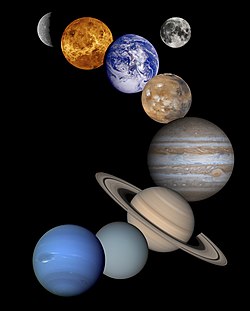Sun
The prospect of the Sun exploding in this manner has been used in several disaster stories. [2] [4] [5] It was recognized early on that the immense destructive power of such an event would leave little to no hope of survival for humanity, and so while Simon Newcomb's 1903 short story "The End of the World" depicts a few survivors in the immediate aftermath, [2] [6] Hugh Kingsmill's 1924 short story also entitled "The End of the World" instead focuses on the anticipation of the destruction of the Earth. [4] [7] According to science fiction scholar Brian Stableford, writing in the 2006 work Science Fact and Science Fiction: An Encyclopedia , it was thus not until the widespread adoption of the concept of space travel in science fiction—hence making evacuation of the Earth a conceivable prospect—that such stories became popular. [2] In John W. Campbell's 1930 short story "The Voice of the Void" humanity leaves Earth ahead of this disaster, [2] [8] while in Joseph W. Skidmore [ Wikidata ]'s 1931 short story "Dramatis Personae" the Sun explodes without warning, leaving a few people already in spaceships as the only survivors. [2] [9] Rescue missions by aliens are sent to Earth in Raymond Z. Gallun's 1935 short story "Nova Solis" and Arthur C. Clarke's 1946 short story "Rescue Party", though in the latter they discover that evacuation has already been undertaken. [2] [10] The Sun exploding occasionally appears as a background event to explain why humanity has abandoned Earth in favour of colonizing the cosmos, [3] one example being Theodore Sturgeon's 1956 short story "The Skills of Xanadu". [2] [11] Clarke's 1958 short story "The Songs of Distant Earth" (later expanded into a 1986 novel bearing the same title) revolves around an encounter between humans who leave Earth shortly before the explosion of the Sun and the members of a centuries-old extrasolar colony. [2] [3] George O. Smith's 1958 novel Fire in the Heavens revisits the theme of anticipating the end of the world as a result of an impending solar explosion, [2] [12] and in Larry Niven's 1971 short story "Inconstant Moon", the sudden brightening of the Moon in the night sky leads the characters to conclude that the Sun has already exploded and will imminently destroy all human life on Earth. [4] [5] [13]
Other stars
It is now recognized that the Sun cannot turn into a supernova (or nova) as the necessary stellar conditions are not met. [a] [1] [3] [14] Earth is nevertheless threatened by the radiation from more distant supernovae in several works. [3] [5] [14] In Richard Cowper's 1974 novel The Twilight of Briareus , a supernova some 100 light-years distant causes a radical shift in the Earth's climate, ushering in a new ice age, [2] [14] [15] while in Ian Watson's 1977 short story "The Roentgen Refugees", Sirius going supernova a mere 9 light-years away sterilizes the entire surface of the Earth. [14] Another supernova in the Sirius system appears in Roger MacBride Allen and Eric Kotani's 1991 novel Supernova , [2] [3] [5] and one in the Alpha Centauri system threatens Earth in Charles Sheffield's 1998 novel Aftermath . [5] [16] In Liu Cixin's 2003 novel Supernova Era , a relatively-nearby but previously undetected star 25 light-years away goes supernova, the radiation causing widespread genetic damage to humans on Earth. [3]
Besides humans, alien civilizations are also subject to the dangers of supernovae in some stories. [3] In Clarke's 1955 short story "The Star", an alien species is found to have gone extinct some two millennia ago when their star exploded, creating the biblical Star of Bethlehem. [1] [2] [3] [5] In Poul Anderson's 1967 short story "Day of Burning" (a.k.a. "Supernova"), humans try to evacuate a planet inhabited by a pre-spacefaring society threatened by a supernova. [2] [5] [16] In Stephen Tall's 1971 short story "The Bear with the Knot on His Tail", such a rescue mission is complicated by the language barrier between the humans and the imperiled aliens. [2] [17] The explosion of its star is also the cause of the planet Krypton's destruction in some iterations of the Superman franchise. [3]


